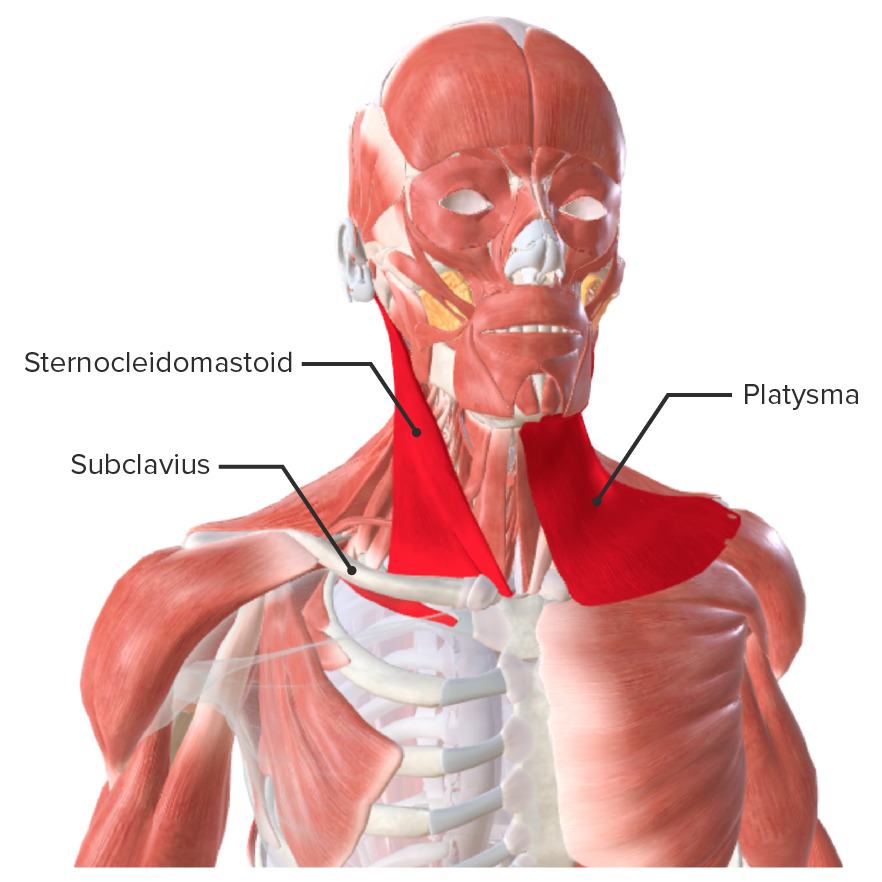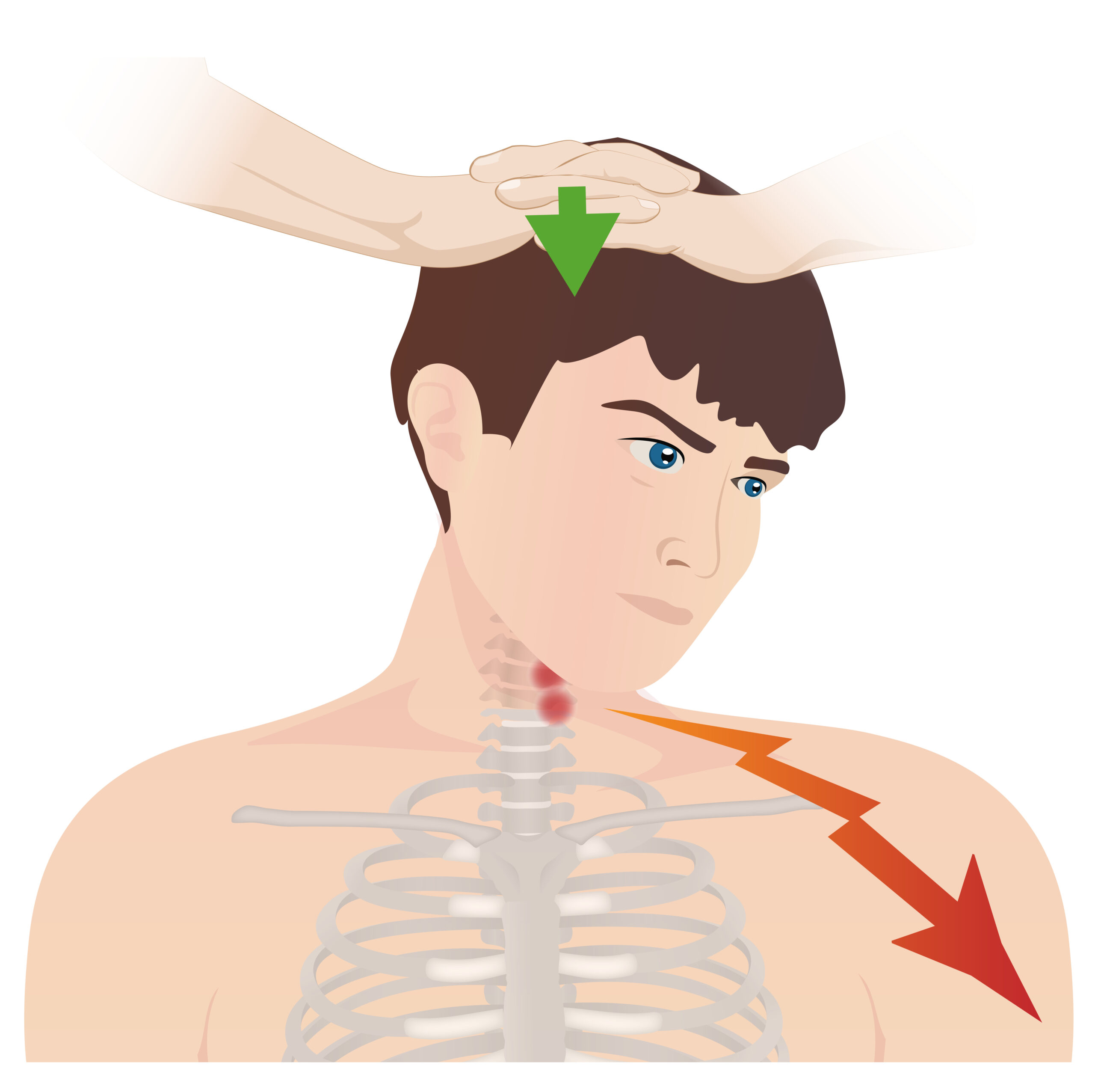Playlist
Show Playlist
Hide Playlist
Examination of the Neck and Back
-
Reference List Physical Examination.pdf
-
Download Lecture Overview
00:01 Alright, so now we're going to jump into the examination of the neck, the low back, and the hips. 00:09 First off, when we're doing inspection of the upper back, we're trying to look for the normal curvature of the spine. 00:15 You know the spine is not just a straight rod from top to bottom, it actually has some natural curvature to it. 00:21 So Shaun, if you could rotate about 45-degrees this way, you can see right off the bat that he has what's called a normal kyphosis, which is right here which is this curvature around the cervical thoracic spine. 00:36 If a person has significant vertebral insufficiency from osteoporotic fractures, you may find them - curve your spine forward before me in the top - great, so you'd have excess kyphosis as the spines were fold forwards due to loss of the vertebral height in the cervical spine. 00:53 So this is the normal kyphotic curve here and then down here there's also curvature in the lumbosacral area where the lumbosacral spine is somewhat concave and that's the normal lordosis of the spine. 01:06 Patients who have significant back spasm for example may have strong contraction of the spinal muscles, the paraspinous muscles down there that would cause in a particularly severe straightening of the spine in this area and loss of the normal lordosis of the spine. 01:25 Alright, facing forward again for me. Inspection would also include looking at the skin. 01:30 You'd hate to have a patient come in with a back pain problem and you don't take their shirt off and then later on you'll realize they just have shingles, you know, from some acute zoster issues. 01:40 So always be sure you're taking a look at the patient's skin whenever you're doing an assessment for pain. 01:45 Next up we're going to go through range of motions. 01:47 So there's three degrees really of motion around the head and also the neck and some of them are more useful than others. 01:56 So first thing I'm going to do is just twisting. 01:58 So I want you to twist to the right, all the way to the right. 02:02 That right and all the way to the left. 02:04 So it turns out that twisting is not a particularly useful measure because it doesn't tell us anything about what's causing a patient's pain. 02:13 Nonetheless, we do it to kind of get a degree of the severity of their discomfort and it's something you could potentially track overtime if your physical therapist are monitoring such things. 02:22 The next range of motions is forward and extension of the spine. 02:26 So I'm going to have you face to the wall, I want you to flex all the way forward. 02:30 This is particularly useful not only because we can look for scoliosis, you're going to look to see if there's any curvature of the spine, but in addition, if somebody has scoliosis, there'll be asymmetry in the height of the paraspinous muscles on one side. 02:45 Scoliosis really becomes more evident when you have your patient lean forward because you'll see a prominence on the left or prominence on the right with abnormalities in your know, lateral bending of the spine. 02:58 This is also a good time to discuss - you can stand up again, Shaun, to discuss the use of the Schober Test. 03:04 This is a useful test for looking for ankylosing spondylitis and if I have - you face the wall one more time again, I'm sorry - you simply would apply a mark in one area on the lower back and another area 10 centimeters distal to that with the marker, then I'll have you lean all the way forward. 03:21 For most people, and you can actually just see this with my hands, there was a dramatic change in the distance between my two fingers and if that change is about 5 centimeters or more they don't have ankylosing spondylitis. 03:34 Now, ankylosing spondylitis is the fusing of those vertebral bodies that would prohibit curving the lordotic or the lumbosacral part of the spine, so you would not see this dramatic excursion in where my fingers are located. 03:48 And stand up again, you see how much those fingers come back together, so that's a very simple Schober Test and that you can do to look for ankylosing spondylitis. 03:56 Lastly, face forward again. 03:58 The one useful test that I find for trying to characterize the etiology of somebody's low back pain is actually lateral flexion, moving from one side to the other. 04:09 So I'm going to have you just laterally flex to your right sort of bringing your right arm down towards the floor and then do the same thing to your left. 04:18 Now if our patient had for example - you can stand up straight again. 04:22 If our patient had right lumbosacral muscle strain, let's say, on the right side, by leaning towards that side he actually won't really have much trouble with that. 04:34 Muscles that are strained don't like to be stretched, so if he's having any spasm in his lumbosacral muscles on the right then we have him tilt to the left, which I'll have you do now. 04:45 That's what's actually going to cause him pain on the right side. 04:49 So patients with right lateral lumbosacral muscle strain will not like being bent over towards the left - you can stand up again. 04:59 The same thing applies for neck problems. 05:01 If somebody has strain in the musculature of the right side of the neck, if I have him laterally flex his neck to the left that's going to cause pain on the right side. 05:11 In contrast, if a person actually has disease of the spine - of the vertebral spine in itself with osteophytes and osteoarthritis with in the facets of either the cervical spine or down in the low spine, if the disease that is causing pain is located on the right facet joints for example on the cervical spine of the neck, if he leans towards the right now with his neck, that's going to exacerbate that pain and cause pain on the right side of his neck. 05:41 The same thing applies with right lateral flexion of his lumbar spine, if he has disease in the facet joints on the right side or if there's a disc herniation or disk bulge on the right side of his spine, by leaning to the right, his now further compressed to those areas and that's going to reproduce his pain on the right-hand side. 06:00 So lateral flexion is extremely useful skill when you're performing your physical exam. 06:05 Next step we're going to palpate the back as the next part of the neck and back exam starting all the way up here with a cervical spine looking for any sensitivity or discomfort, tenderness as we march down these paraspinous muscles, all the way down here, a little bit further out into the lumbosacral musculature down here, moving over the scapulae and the rhomboids here, a lot of times people will have pain in their back and it's actually just pain between the shoulder blades over the rhomboid musculature and then of course feeling the trapezius muscles as well which can be a source of discomfort. 06:42 Lastly, you want to palpate down the spinous processes themselves to look for any specific points of tenderness which could be an indication of potentially an osteoporotic compression fracture, discitis, osteomyelitis, or even potentially a recent traumatic fracture. 06:59 I have you face front again. 07:01 Keep in mind that while palpation is certainly something that you should do and can give you an idea as to the extent of the person's pain or tenderness in certain areas, it's not particularly diagnostically useful. 07:13 I've had many patients who may have facet joint arthritis in one area or potentially have a compression fracture over the spine or simply have lumbosacral muscles strain or disc herniations, whatever the cause, and they may have paraspinal tenderness that doesn't really correlate with what we end up finding on other parts of the physical exam. 07:34 So I think it's worth doing but don't hang your head on it, particularly when we know that patients who have a disk herniation, for example, that encroaches on a nerve root while that's the source of the pain it can cause reflex muscle spasm in the adjacent paraspinous musculature, so they may have soreness in those muscles but that's not what actually is causing the person's pain or at least not what precipitated the person's pain. 08:01 The last part in terms of the spine and the low back exam would involve the neuromuscular section which is where we're going to look for strength, look at reflexes and other sensory manifestation suggestive of a radiculopathy or potentially a myelopathy, but that's going to be part of the neurologic section that we'll do after this lecture.
About the Lecture
The lecture Examination of the Neck and Back by Stephen Holt, MD, MS is from the course Examinations of the Neck and Back Region.
Included Quiz Questions
The natural kyphosis of the spine is in which area?
- Thoracic spine
- Sacroiliac joints
- Lumbar spine
- The entire spine
Which physical exam maneuver tests for ankylosing spondylitis?
- Flexion
- Hyperextension
- Lateral bending
- Twisting from side to side
- Palpation of the paraspinal muscles
For what disease does the Schober test of limited flexion in the spine evaluate?
- Ankylosing spondylitis
- Scoliosis
- Sacroiliitis
- Paraspinal muscle spasm
- Herpes zoster
Palpation of the spinous processes can reveal point tenderness with which condition?
- Vertebral fracture due to osteoporosis
- Scoliosis
- Herpes zoster
- Degenerative disc disease
- Sacroiliitis
Customer reviews
5,0 of 5 stars
| 5 Stars |
|
1 |
| 4 Stars |
|
0 |
| 3 Stars |
|
0 |
| 2 Stars |
|
0 |
| 1 Star |
|
0 |
1 customer review without text
1 user review without text






